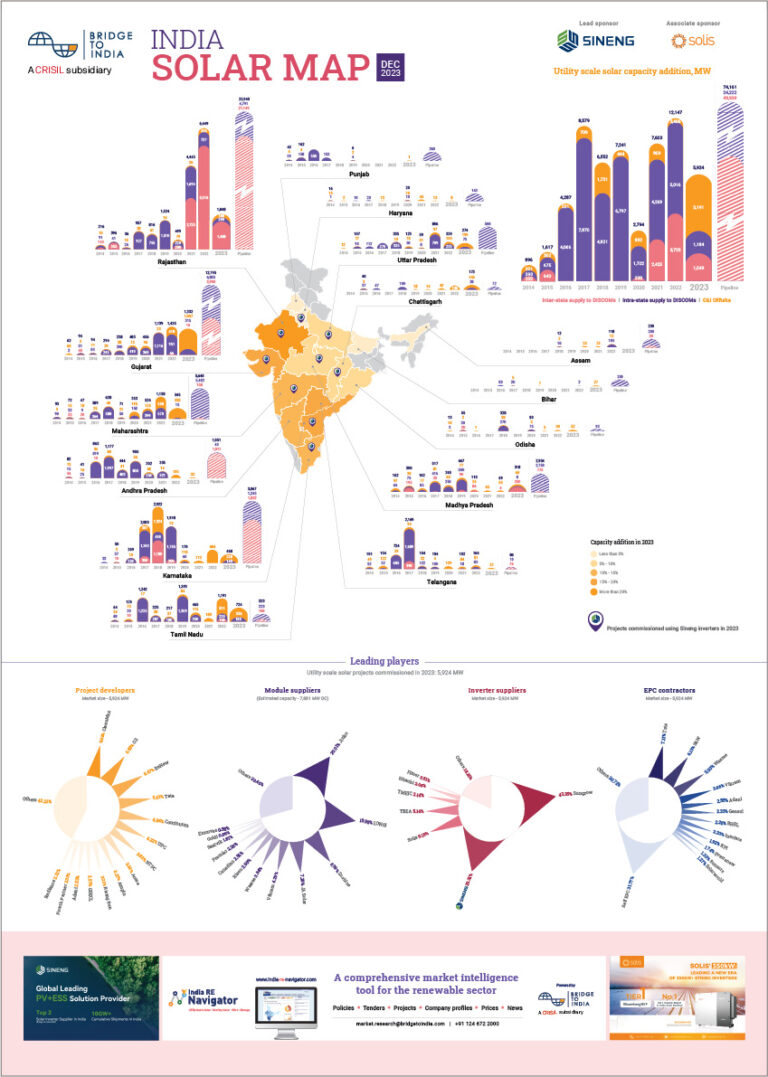After a year of deliberation, MNRE has announced that basic customs duty (BCD) shall be levied on all cell and module imports from 1 August 2020 onwards. The proposal, pending approval from The Ministry of Commerce and Ministry of Finance, mentions 15% and 20% duty rates on cell and modules in the first year, going up to 30% and 40% respectively from second year onwards. MNRE has indicated that the duties are expected to stay for a long time with no set date for expiry.
- Adani, Tata Power, Vikram and Waaree would be the main beneficiaries but most of them would be keen to enter into JVs with Chinese companies for financing, technology and procurement assistance;
- A comprehensive and well-planned manufacturing policy is needed alongside BCD for shoring up domestic manufacturing competitiveness;
- BCD effect would take about two years to trigger as developers would continue to import from China because of cheaper prices and ‘change in law’ protection;
The government has been deliberating on customs duty for over a year now. COVID-19 and border dispute with China have hardened the government stance on both timing and level of duties. Most likely, the duty shall also be applicable on various components including glass, frames and chemicals but polysilicon and wafers would be exempted. There is no clarity as yet if the duties would be applicable on inverters also.
Figure: Solar duty structure

Figure: BRIDGE TO INDIA research
Will BCD actually lead to manufacturing investment in India?
Yes, but only to a limited extent. The proposed duty levels are sufficient to tide over the cost disadvantage of domestic manufacturing. We expect Adani, Tata Power, Vikram and Waaree to be the main beneficiaries and most obvious candidates for expansion. Most of them are likely to look for JV opportunities with Chinese companies for financing, technology and procurement assistance. US-based First Solar is a potential candidate. There may also be 1-2 dark sheep, possibly leading industrial houses in India. Reliance, Jindal and Mahindra have shown intent in the past to enter solar manufacturing business. But we do not see any material interest from the Chinese, for obvious reasons.
Will India become a solar manufacturing superpower?
Sadly, no. BCD alone is not going to cut it. The Chinese players dominate solar manufacturing through substantial investments in scale, R&D and value chain control. Indian companies have mammoth capability gaps and would continue to rely heavily on Chinese suppliers. Imports meet 40-60% of domestic requirement across the capital goods sector because of shallow technology capability, fragmented scale and high cost structure. Moreover, with the economy weakening and banks not keen to lend, financing would be a major hurdle.
India’s notoriously fickle policy regime also does not help. A comprehensive and well-planned manufacturing policy is essential for shoring up domestic manufacturing competitiveness.
Will we gain complete energy security?
For the reasons discussed above, not in the next 5-7 years at the very least.
What will be the impact on tariffs? Will DISCOMs still buy solar power?
A 40% duty would increase tariffs by INR 0.50-0.55/ kWh. Solar would still remain far cheaper than conventional power but demand over 1-2 years would be subdued partly because of excess supply situation.
What will be the impact on current project pipeline?
Setting aside 12 GW capacity allocated in the manufacturing-linked tender, India has a solar project pipeline of 27.2 GW. Fundamentally, there should be no adverse impact on the pipeline projects as most tenders offer an all-encompassing ‘change in law’ protection. The developers would continue to import from China because of cheaper prices. But the problem would be funding incremental capital cost as lenders would not be keen to do so. We estimate equity requirement of projects to almost double posing a major (but temporary) headache for the developers.
About 2.1 GW of the pipeline is earmarked for domestic modules. Netting that off and assuming a typical DC:AC ratio of 1.4x leaves us with 35 GW market for imported modules over the next 2-3 years. Assurance of this business makes the Chinese companies reluctant to invest in India in the short-term.
What about rooftop solar and OA markets?
These markets are already bearing 15% safeguard duty burden. The impact of 5% additional duty would be negligible. Implementation of the duty structure along planned lines should lead to a temporary burst in activity in 2020-21 as demand comes forward in anticipation of higher duty from August 2021 onwards. Longer-term impact may not be material either because of the falling cost trajectory.












